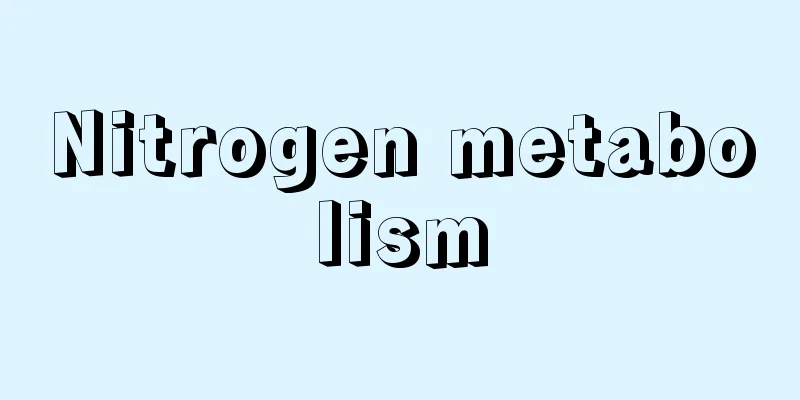Nitrogen metabolism

|
The process by which nitrogen and nitrogen-containing compounds are transformed within living organisms is called nitrogen metabolism. The form of nitrogen that organisms ingest from the outside world varies from organism to organism, and can be divided into nitrogen-fixing organisms that fix atmospheric molecular nitrogen to synthesize organic nitrogen compounds, plants and bacteria that assimilate inorganic nitrogen compounds such as nitrate, and animals and some microorganisms that can only use organic nitrogen compounds. Organisms that can use atmospheric molecular nitrogen are limited to bacteria such as Azotobacter and Clostridium that live underground, rhizobia that form nodules in symbiosis with the roots of legumes, and some actinomycetes and blue-green algae. These nitrogen-fixing organisms have nitrogenase, which directly activates free nitrogen, as well as an enzyme system for reduction. Molybdenum and iron are essential for this nitrogen fixation reaction, and ammonia is the product, but a stable intermediate substance in this reaction has not yet been found. Organisms that use inorganic nitrogen compounds, such as plants, generally ingest nitrogen in the form of nitrate from the soil. This is because ammonia in the soil is immediately oxidized to nitrate by nitrifying bacteria. Nitrate absorbed by plant roots is reduced to ammonia by enzymes of the nitrate reduction system. Ammonia is converted to glutamine by glutamine synthetase, and then to glutamic acid by glutamate synthetase. Other amino acids are synthesized from this amino acid, which is then synthesized into proteins. In bacteria and algae, glutamic acid is also produced from ammonia by glutamate dehydrogenase, and amino acids and proteins are synthesized from this. Organisms that can only use organic nitrogen compounds, such as animals, synthesize their own proteins using amino acids absorbed as food. This process of converting external nitrogen compounds into living organisms' constituent substances is called nitrogen assimilation. Meanwhile, nitrogen compounds in living organisms are constantly being metabolized and transformed. Proteins are hydrolyzed into amino acids, and then deaminated and broken down through reactions such as oxidation. Ammonia produced by the deamination reaction is often accumulated in plants as amides of glutamine or asparagine, but in animals it is excreted from the body as ammonia or after being converted to urea or uric acid. Some bacteria perform nitrate respiration under anaerobic conditions, using nitrate as an electron acceptor for respiration, while others perform denitrification, releasing nitrogen gas. Nitrifying bacteria present in soil oxidize ammonia to nitrate under aerobic conditions, and use the energy released during this process to perform carbon dioxide assimilation. [Seiichi Yoshida] Source: Shogakukan Encyclopedia Nipponica About Encyclopedia Nipponica Information | Legend |
|
窒素、および窒素を含む化合物が、生体内で変換される過程を総称して窒素代謝という。生物が外界から摂取する窒素の形態は生物によって異なり、大気中の分子状窒素を固定して有機窒素化合物を合成する窒素固定生物、硝酸などの無機窒素化合物を同化する植物および細菌類、有機態の窒素化合物しか利用できない動物および一部の微生物などに分けられる。大気中の分子状窒素を利用できる生物は、地中にすむアゾトバクターやクロストリジウムなどの細菌類、マメ科植物などの根に共生して根粒を形成する根粒菌、および一部の放線菌、藍藻(らんそう)などに限られている。これらの窒素固定生物は、遊離窒素を直接活性化するニトロゲナーゼのほか、還元のための酵素系をもっている。この窒素固定反応にはモリブデンと鉄が不可欠であり、アンモニアが生成物であるが、この反応において安定な中間物質はまだみいだされていない。 植物などのように無機態の窒素化合物を利用する生物は、一般に土壌から硝酸態の窒素を摂取する。これは、土壌中のアンモニアが硝化細菌によって、ただちに硝酸まで酸化されるためである。植物の根から吸収された硝酸塩は、硝酸還元系の酵素によってアンモニアに還元される。アンモニアはグルタミン合成酵素によってグルタミンとなり、ついでグルタミン酸合成酵素によってグルタミン酸となる。このアミノ酸から他のアミノ酸が合成され、さらにタンパク質に合成される。細菌や藻類では、このほかにグルタミン酸デヒドロゲナーゼによってアンモニアからグルタミン酸が生成し、これからアミノ酸、タンパク質が合成される。動物などのように有機態の窒素化合物しか利用できない生物は、食物として吸収したアミノ酸などを素材として生物自体に固有のタンパク質を合成する。このように外界の窒素化合物を生体の構成物質に変える過程を窒素同化という。 一方、生体内の窒素化合物は絶えず代謝され、変換されている。タンパク質はアミノ酸に加水分解され、さらに酸化などの反応によって脱アミノされて分解していく。脱アミノ反応で生成したアンモニアは、植物ではグルタミンやアスパラギンのアミドとなって蓄積されることが多いが、動物ではアンモニアのまま、あるいは尿素や尿酸に変えられてから体外に排出される。細菌のなかには、嫌気的な条件で硝酸を呼吸の電子受容体として硝酸呼吸を行うものや、窒素ガスとして放出する脱窒素作用を行うものもある。また、土壌中に存在する硝化細菌は、好気的条件でアンモニアを硝酸まで酸化して、その際に放出されるエネルギーを用いて炭酸同化を行っている。 [吉田精一] 出典 小学館 日本大百科全書(ニッポニカ)日本大百科全書(ニッポニカ)について 情報 | 凡例 |
<<: Nitrogen Determination Method
>>: Nitrogen oxides - Nitrogen staghorn fern
Recommend
Inukaibe - Inukaibe
One of the Shinabe clans in the pre-Taika period. ...
Winfield, JR - Winfield
…the American name for polyethylene terephthalate...
Akeyashiki Igamono - Akeyashiki Igamono
…Apart from these, there were also those who were...
Giant Camel - Giant Camel
...The Japanese name comes from the fact that the...
Ruggero I
?‐1101 Count of Sicily. Youngest son of Tancredi, ...
Kyoy - Kyoy
...The fact that the term 'difkan', which...
Semisulcospira kurodai (English spelling) Semisulcospirakurodai
…Haikyuchuu [Namibe Tadashige]. . . *Some of the ...
Yoshihide Otsubo
Year of death: 1407 Year of birth: 1324 An equestr...
Scorpion - Scorpion
A general term for the Scorpionidae order of the A...
Audio equipment industry
This industry manufactures products that record an...
Masaoki Shinmi
A shogunate official during the late Edo period, ...
Loan - Shakkan (English spelling) Loan
Generally refers to the borrowing and lending of ...
Salgado, P. (English)
…The 1930s Brazilian fascist party, the colloquia...
Korean Writers Union - Chosen Sakka Domei
An organization of writers in the Democratic Peopl...
Dohachi Tsuruzawa
A shamisen player of Gidayu-bushi. (1) The First (...





![Taiki [town] - Taiki](/upload/images/67cc158f15c03.webp)



